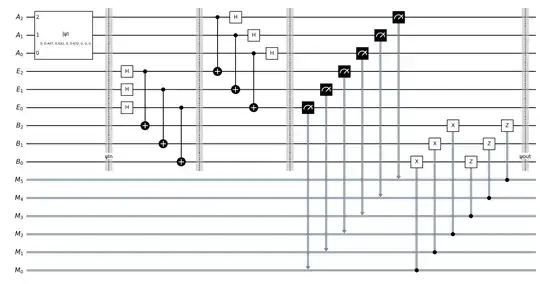As mentioned in the link shared the the OP, a simple way to extend the teleportation protocol to $n$ qubits is to basically replicate the teleportation procedure for each of the qubits. This works even if the state to be teleported is entangled.
However, for sake of clarity, I am posting a separate answer here since the example given in the original post is specifically for 2 qubits, uses deferred measurements, and shows the answer in terms of measured probabilities, which is not a guarantee that the state was teleported with the correct phases.
The Qiskit code below works for an arbitrary number of $n$ qubits. The only adjustment needed is to make sure the list used to define the state ψ is of size $2^n$ and represents the normalized probability amplitudes of a valid statevector.
# imports
import numpy as np
from qiskit import QuantumCircuit, QuantumRegister, ClassicalRegister, transpile
from qiskit.quantum_info import Statevector, partial_trace
from qiskit_aer import AerSimulator
Number of qubits
n = 3
Arbitrary amplitudes to prepare state |ψ⟩ = α|001⟩ + β|010⟩ + γ|100⟩
α = np.sqrt(1/6)
β = np.sqrt(2/6)
γ = np.sqrt(3/6)
Prepare arbitrary state vector
ψ = [0,α,β,0,γ,0,0,0]
Define quantum registers
qrA = QuantumRegister(n, name="A")
qrE = QuantumRegister(n, name="E")
qrB = QuantumRegister(n, name="B")
Define classical register
cr = ClassicalRegister(2*n, name='M')
Compose quantum circuit
qc = QuantumCircuit(qrB, qrE, qrA, cr)
qc.prepare_state(ψ,qrA, label="$| \psi \rangle$")
qc.save_statevector('ψin')
for i in reversed(range(n)):
qc.h(qrE[i])
qc.cx(qrE[i],qrB[i])
qc.barrier()
for i in reversed(range(n)):
qc.cx(qrA[i],qrE[i])
qc.h(qrA[i])
qc.barrier()
qc.measure(qrE,cr[0:n])
qc.measure(qrA,cr[n:2*n])
for i in range(2*n):
if i < n:
qc.x(qrB[i]).c_if(i,1)
else:
qc.z(qrB[i-n]).c_if(i,1)
qc.save_statevector('ψout')
Transpile circuit
sim = AerSimulator()
qc_t = transpile(qc, sim)
Run Sim
result = sim.run(qc_t).result()
Extract Statevectors
ψin = result.data().get('ψin')
ψout = result.data().get('ψout')
Trace out syndrome qubits
ρin = partial_trace(ψin,range(0,2n))
ρout = partial_trace(ψout,range(n,3n))
transform back to statevector
ψin = ρin.to_statevector()
ψout = ρout.to_statevector()
print('State prepared by Alice:')
display(ψin)
print('State received by Bob:')
display(ψout)
This code produces the following circuit to teleport 3 qubits:

and generates the following output, which shows that the state Bob receives matches the state Alice prepared:
State prepared by Alice:
$ \frac{\sqrt{6}}{6} |001\rangle+\frac{\sqrt{3}}{3} |010\rangle+\frac{\sqrt{2}}{2} |100\rangle $
State received by Bob:
$ \frac{\sqrt{6}}{6} |001\rangle+\frac{\sqrt{3}}{3} |010\rangle+\frac{\sqrt{2}}{2} |100\rangle $
